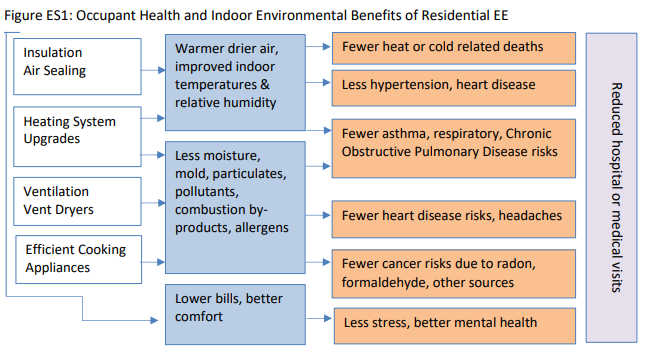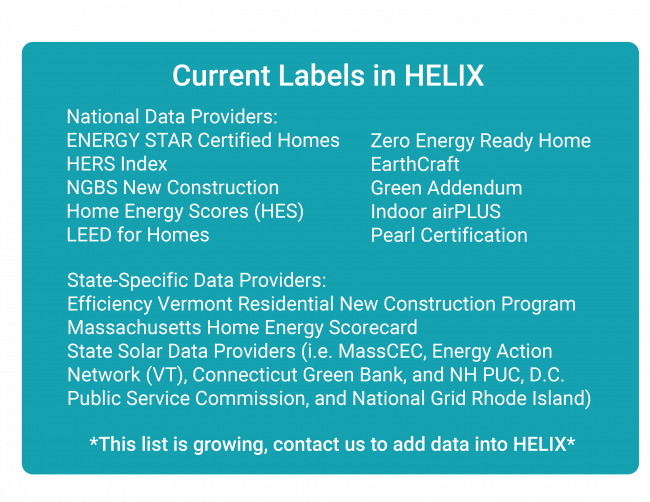

By Bryan Evans | Thu, March 25, 21
For many, our home is the place we find peace, comfort, and relaxation. You sleep, eat, play, and now even work from home. As I write this blog in March 2021, it has been over one year since I started working from home in continued efforts to flatten the curve of the COVID-19 pandemic. After spending extended periods of time in my home, I became more curious about the link between energy efficiency and the health of the place in which we spend most of our time.
Before I got into my line of work, I would have never made a connection between what it means for a home to be healthy and what it means for a home to be energy efficient. To me, a healthy home would avoid the use of harmful chemicals in paint, flooring, cabinets, and cleaning products; have proper ventilation, especially in the bathrooms and kitchens; and avoid conditions or products during construction that are linked to poor health outcomes, like radon, moisture or mold, pests, and extreme cold or heat. Alternatively, I would have thought that the energy efficiency of homes was reliant only on efficient lighting, appliances, and systems to reduce the consumption of energy, water, and resources. Little did I know that the connection between energy efficiency and health are much more aligned than I originally guessed.
Energy efficiency improvements are, inherently, health improvements; they focus on improving indoor air quality “to create a drier home with more consistent temperatures, fewer indoor air pollutants, reduced allergens, and fewer asthma triggers (changes in temperatures, dampness, mold, mice or insect droppings).” Depicted in the graphic above from a 2016 E4TheFuture report, Occupant Health Benefits of Residential Energy Efficiency, reveals just that – the connection between energy efficiency and health benefits. Listed below are some key findings on how energy efficiency provides health benefits:
- “Air sealing and insulation can improve indoor temperatures, reduce dampness or moisture issues, and exclude mice and cockroaches. Repairs or upgrades to HVAC system, as well as new tight windows and doors can also help reduce air pollutants that trigger sinus infections, asthma and other respiratory symptoms.”
- “Improving indoor temperatures to create warmer homes, and reducing fine particulate matter and air pollutants through improved ventilation and heating system/cooking appliance upgrades, can help to reduce Chronic Obstructive Pulmonary Disease (COPD) risks”
- “Physical and mental health can be impacted by both physical environmental conditions and financial hardships due to fuel bills. Energy efficiency can help make homes warmer or reduce temperatures in homes prone to overheating, reduce high energy bills which can create stress, and improve environmental conditions that can disrupt sleep”
Creating an Equitable, Healthier Community
To further promote sustainability and equity, the connection between energy efficiency and health must realize energy justice issues. Low-income families are disproportionately affected by high energy burdens and are willing to sacrifice food, healthcare, and other needs to pay their bills and avoid utility shutoffs. The growing divide in energy affordability and access to energy efficiency benefits calls for increased targeting of efficiency initiatives in low- to moderate-income (LMI) communities. Research from the American Council for an Energy-Efficient Economy (ACEEE) Energy Burden report found that the medium energy burden of low-income households is three times higher than that of non-low income households. Low-income households are often older, more inefficient buildings that cause high energy bills. In addition, the Oak Ridge National Laboratory found in its 2020 report, Low-Income Energy Affordability: Conclusions from a Literature Review, that residents who live in inefficient housing experience higher levels of adverse health effects from high energy burdens. This includes higher levels of exposure to indoor air pollution from inefficient and improper use of heating systems, appliances, and poor ventilation that lead to an increase of cases for respiratory, heart, and other issues. In order to effectively scale up opportunities to reduce high financial burdens from energy bills and improve the health of a home, energy efficiency programs should increase educational efforts around health impacts of energy efficiency and increase outreach to traditionally underserved communities.
Key findings in the E4TheFuture report shows that homes where energy efficiency education is supplemented with home repairs create a 23 percent greater improvement in asthma symptoms compared to a home whose residents only receive home education visits. The report presents key observations and findings that detail improvements in overall health, indoor environmental conditions, increased mental health, and monetary benefits from health and efficiency improvements. Similarly, ACEEE’s Energy Burden report found that low-income, Black, Hispanic, and Native American households all face dramatically higher energy burdens than the average household.
Residents shouldn’t have to make difficult trade-offs between paying energy bills and paying for other human necessities. Providing more pathways for low-income households to achieve energy affordability and reap the benefits of healthy, efficient homes will improve equity and create healthier communities in all neighborhoods.
No More Surprises!
Homebuyers and renters tend to overlook a home's energy performance and costs. It is an easy oversight since most major American real estate websites do not include fields for energy efficiency and renewable attributes. Most people realize their home’s energy usage once monthly bills start rolling in, which is long after someone is locked into a lease or mortgage. Home energy labeling initiatives look to fill this gap in the market through transparency around energy usage and valuation of energy efficiency. Home energy labeling can connect the dots between energy usage and healthy environments.
Home energy labeling is the assessment of a home’s energy performance and features that provides valuable information for real estate professionals, homeowners, buyers, and renters. Throughout the real estate process, accessible energy labels and information about energy efficiency features support the ability to leverage real estate decisions and investments in efficiency upgrades. With energy efficiency and home energy labeling programs successfully implemented throughout the country, homeowners and renters have been able to make informed decisions about home improvements.
To better prepare for your home buying or renting journey, be sure to tune into NEEP’s Guide for Renting and Creating Lower Cost Energy Efficiency Apartments and Homes and the Home Buyers Energy Efficiency Checklist. These resources will guide you on what to look for in order to understand the efficiency and quality of the heating and cooling systems, appliances, windows, insulation and more and ways to manage and save energy.
HELIX: A Solution in the Northeast
Throughout the Northeast, the Home Energy Labeling Information eXchange (HELIX) acts as a policy management tool and as a mechanism to automatically populate residential home energy information into Multiple Listing Services (MLS) listings. HELIX stores home energy labels, certifications, solar PV and program data (shown on the right) and has the ability to store different indoor air quality labels to promote health.
The last year has shown us that our homes must provide healthy, efficient, and affordable living conditions for all occupants. Similarly, the pandemic has given us a chance to put health at the forefront of our mind, creating an opportunity to affect air quality and mitigate future health crises by making the air we breathe and the spaces we live, work, and play in safe for all. Energy efficiency and renewable energy investments can produce significant benefits by improving the health of occupants, reducing energy bills and burdens, increasing workforce development opportunities, and enhancing grid reliability.



